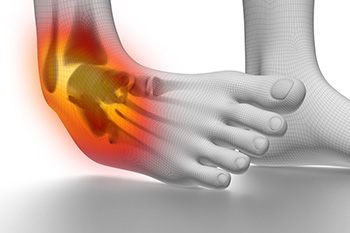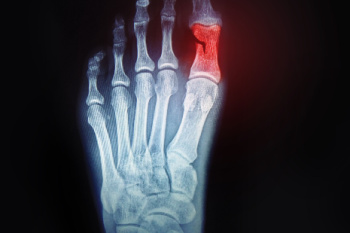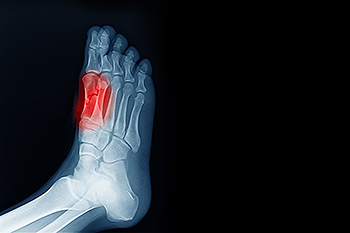Connect With Us
Blog
Items filtered by date: January 2025
Types and Treatment of Ankle Sprains

Ankle sprains occur when the ligaments supporting this complex joint are stretched or torn. Ankle sprains are classified into three grades, based on severity. Grade 1 sprains involve mild stretching of the ligaments, causing slight pain and swelling. Grade 2 sprains are moderate, with partial tearing of the ligaments, leading to noticeable swelling, bruising, and difficulty walking. Grade 3 sprains are severe, involving complete ligament tears, significant swelling, instability, and an inability to bear weight. Risk factors include improper footwear, uneven surfaces, and activities requiring sudden movements. A podiatrist can assess the extent of the sprain through a detailed exam and use imaging tests to rule out fractures. Treatment options include braces or casts to stabilize the ankle and allow proper healing, with a focus on preventing chronic issues like instability. In cases of a Grade 3 sprain, surgery may be required to restore joint function. If you have sprained an ankle, it is suggested that you make an appointment with a podiatrist for an exam and treatment options.
Ankle sprains are common but need immediate attention. If you need your feet checked, contact one of our podiatrists from Boca Raton Podiatry . Our doctors can provide the care you need to keep you pain-free and on your feet.
How Does an Ankle Sprain Occur?
Ankle sprains take place when the ligaments in your ankle are torn or stretched beyond their limits. There are multiple ways that the ankle can become injured, including twisting or rolling over onto your ankle, putting undue stress on it, or causing trauma to the ankle itself.
What Are the Symptoms?
- Mild to moderate bruising
- Limited mobility
- Swelling
- Discoloration of the skin (depending on severity)
Preventing a Sprain
- Wearing appropriate shoes for the occasion
- Stretching before exercises and sports
- Knowing your limits
Treatment of a Sprain
Treatment of a sprain depends on the severity. Many times, people are told to rest and remain off their feet completely, while others are given an air cast. If the sprain is very severe, surgery may be required.
If you have suffered an ankle sprain previously, you may want to consider additional support such as a brace and regular exercises to strengthen the ankle.
If you have any questions please feel free to contact our office located in Boca Raton, FL . We offer the newest diagnostic and treatment technologies for all your foot and ankle needs.
Do You Suffer From Painful Feet?
Definition and Causes of a Broken Toe

A broken toe occurs when one of the bones in the toe is fractured due to excessive force or impact. This type of injury is common and can range from a small crack to a complete break. The most frequent cause of a broken toe is trauma, such as stubbing the toe against a hard object or dropping something heavy on it. Athletes and active individuals are more prone to this injury due to the physical demands of sports and activities that involve running or jumping. Other causes include accidents, falls, or even repetitive stress over time. Symptoms of a broken toe include severe pain, swelling, bruising, and difficulty moving the toe. In some cases, the toe may appear misaligned or deformed. Proper diagnosis through an X-ray is important to determine the severity of the fracture and ensure appropriate treatment. If you have broken your toe, it is suggested that you visit a podiatrist as quickly as possible who can begin the correct treatment for proper healing.
A broken toe can be very painful and lead to complications if not properly fixed. If you have any concerns about your feet, contact one of our podiatrists from Boca Raton Podiatry . Our doctors will treat your foot and ankle needs.
What to Know About a Broken Toe
Although most people try to avoid foot trauma such as banging, stubbing, or dropping heavy objects on their feet, the unfortunate fact is that it is a common occurrence. Given the fact that toes are positioned in front of the feet, they typically sustain the brunt of such trauma. When trauma occurs to a toe, the result can be a painful break (fracture).
Symptoms of a Broken Toe
- Throbbing pain
- Swelling
- Bruising on the skin and toenail
- The inability to move the toe
- Toe appears crooked or disfigured
- Tingling or numbness in the toe
Generally, it is best to stay off of the injured toe with the affected foot elevated.
Severe toe fractures may be treated with a splint, cast, and in some cases, minor surgery. Due to its position and the pressure it endures with daily activity, future complications can occur if the big toe is not properly treated.
If you have any questions please feel free to contact our office located in Boca Raton, FL . We offer the newest diagnostic and treatment technologies for all your foot and ankle needs.
What Is Sesamoiditis?

Sesamoiditis is a type of tendonitis that affects the two sesamoid bones that are located beneath the big toe joint. This condition occurs when the tendons surrounding these bones become inflamed, typically due to overuse or repetitive pressure. Symptoms of sesamoiditis include pain beneath the big toe, swelling, and tenderness, especially when walking, running, or bearing weight on the affected foot. You may also have trouble moving the toe or experience discomfort when wearing shoes. The primary cause of sesamoiditis includes activities that place repetitive pressure on the big toe, such as running, ballet, or jumping. Wearing ill-fitting shoes or high heels can also contribute to the condition. A podiatrist can help diagnose sesamoiditis through physical exams and imaging. Treatments may include rest, anti-inflammatory medications, custom orthotics to relieve pressure, or specific exercises to strengthen the foot. In severe cases, corticosteroid injections or surgery may be considered. If you have any of the above symtpoms, it is suggested that you schedule an appointment with a podiatrist.
Sesamoiditis is an unpleasant foot condition characterized by pain in the balls of the feet. If you think you’re struggling with sesamoiditis, contact one of our podiatrists of Boca Raton Podiatry . Our doctors will treat your condition thoroughly and effectively.
Sesamoiditis
Sesamoiditis is a condition of the foot that affects the ball of the foot. It is more common in younger people than it is in older people. It can also occur with people who have begun a new exercise program, since their bodies are adjusting to the new physical regimen. Pain may also be caused by the inflammation of tendons surrounding the bones. It is important to seek treatment in its early stages because if you ignore the pain, this condition can lead to more serious problems such as severe irritation and bone fractures.
Causes of Sesamoiditis
- Sudden increase in activity
- Increase in physically strenuous movement without a proper warm up or build up
- Foot structure: those who have smaller, bonier feet or those with a high arch may be more susceptible
Treatment for sesamoiditis is non-invasive and simple. Doctors may recommend a strict rest period where the patient forgoes most physical activity. This will help give the patient time to heal their feet through limited activity. For serious cases, it is best to speak with your doctor to determine a treatment option that will help your specific needs.
If you have any questions please feel free to contact our office located in Boca Raton, FL . We offer the newest diagnostic and treatment technologies for all your foot and ankle needs.
Key Facts About Clubfoot

Clubfoot is a congenital condition where a baby’s foot is twisted out of shape or position, often with the toes pointing downward and inward. This condition affects one or both feet and occurs during fetal development. While the exact cause of clubfoot is unknown, it is believed to result from a combination of genetic and environmental factors. Clubfoot is diagnosed shortly after birth through a physical examination, and in some cases, an ultrasound may detect it before birth. Treatment for clubfoot typically involves a non-surgical procedure known as the Ponseti method, which uses gentle stretching and casting to correct the position of the foot. In more severe cases, surgery may be needed. With early intervention and appropriate treatment, most children with clubfoot can lead active and healthy lives, walking without pain or disability. If your child has been born with clubfoot, it is suggested that you include a podiatrist on your healthcare team for optimum recovery results.
Congenital foot problems require immediate attention to avoid future complications. If you have any concerns, contact one of our podiatrists of Boca Raton Podiatry . Our doctors can provide the care you need to keep you pain-free and on your feet.
Congenital foot problems are deformities affecting the feet, toes, and/or ankles that children are born with. Some of these conditions have a genetic cause while others just happen. Some specific foot ailments that children may be born with include clubfeet, polydactyly/macrodactyly, and cleft foot. There are several other foot anomalies that can occur congenitally. What all of these conditions have in common is that a child may experience difficulty walking or performing everyday activities, as well as trouble finding footwear that fits their foot deformity. Some of these conditions are more serious than others. Consulting with a podiatrist as early as possible will help in properly diagnosing a child’s foot condition while getting the necessary treatment underway.
What are Causes of Congenital Foot Problem?
A congenital foot problem is one that happens to a child at birth. These conditions can be caused by a genetic predisposition, developmental or positional abnormalities during gestation, or with no known cause.
What are Symptoms of Congenital Foot Problems?
Symptoms vary by the congenital condition. Symptoms may consist of the following:
- Clubfoot, where tendons are shortened, bones are shaped differently, and the Achilles tendon is tight, causing the foot to point in and down. It is also possible for the soles of the feet to face each other.
- Polydactyly, which usually consists of a nubbin or small lump of tissue without a bone, a toe that is partially formed but has no joints, or an extra toe.
- Vertical talus, where the talus bone forms in the wrong position causing other bones in the foot to line up improperly, the front of the foot to point up, and the bottom of the foot to stiffen, with no arch, and to curve out.
- Tarsal coalition, when there is an abnormal connection of two or more bones in the foot leading to severe, rigid flatfoot.
- Cleft foot, where there are missing toes, a V-shaped cleft, and other anatomical differences.
- Macrodactyly, when the toes are abnormally large due to overgrowth of the underlying bone or soft tissue.
Treatment and Prevention
While there is nothing one can do to prevent congenital foot problems, raising awareness and receiving neonatal screenings are important. Early detection by taking your child to a podiatrist leads to the best outcome possible.
If you have any questions please feel free to contact our office located in Boca Raton, FL . We offer the newest diagnostic tools and technology to treat your foot and ankle needs.

